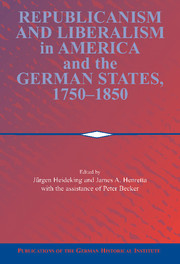Book contents
- Frontmatter
- Introduction
- PART I OVERVIEW
- PART II THE REPUBLICAN WORLD
- PART III THE TRANSITION FROM REPUBLICANISM TO LIBERALISM
- 7 The Liberal and Democratic Republicanism of the First American State Constitutions, 1776-1780
- 8 Bennington and the Green Mountain Boys: The Emergence of Liberal Democracy in Vermont, 1760-1850
- 9 The Birth of American Liberalism: New York, 1820-1860
- 10 Republicanism, Liberalism, and Market Society: Party Formation and Party Ideology in Germany and the United States, c. 1825-1850
- 11 Festive Culture and National Identity in America and Germany, 1760-1860
- 12 Charles Follen’s View of Republicanism in Germany and the United States, 1815-1840
- PART IV THE LOGIC OF LIBERALISM
- Index
11 - Festive Culture and National Identity in America and Germany, 1760-1860
Published online by Cambridge University Press: 05 January 2013
- Frontmatter
- Introduction
- PART I OVERVIEW
- PART II THE REPUBLICAN WORLD
- PART III THE TRANSITION FROM REPUBLICANISM TO LIBERALISM
- 7 The Liberal and Democratic Republicanism of the First American State Constitutions, 1776-1780
- 8 Bennington and the Green Mountain Boys: The Emergence of Liberal Democracy in Vermont, 1760-1850
- 9 The Birth of American Liberalism: New York, 1820-1860
- 10 Republicanism, Liberalism, and Market Society: Party Formation and Party Ideology in Germany and the United States, c. 1825-1850
- 11 Festive Culture and National Identity in America and Germany, 1760-1860
- 12 Charles Follen’s View of Republicanism in Germany and the United States, 1815-1840
- PART IV THE LOGIC OF LIBERALISM
- Index
Summary
FESTIVE CULTURE AS A CREATIVE FORCE
During the past decade public festivals and civic celebrations have become a favorite topic of scholarly investigation and debate. This growing academic interest has certainly been stimulated by great commemorative events such as the bicentennials of the U.S. Constitution and the French Revolution, the 150th anniversary of the Hambach Festival, and the 500th anniversary of Columbus's first voyage to America. Another source of inspiration as well as anxiety has been the revival of the nation-state and nationalism in the wake of the Eastern European revolutions of 1989-90 and German reunification. These external political influences coincided with a new trend in the social and cultural sciences: Political and social scientists are studying ceremonies, cults, rituals, and symbols to gain insight into the popular reception of ideas and ideologies, into mechanisms of social integration and exclusion, and into processes of communication that shape the “public sphere” of modern societies. Anthropologists and cultural historians have asked questions about the genesis and development of mentalities and collective identities, about the forms and functions of “social memory,” as well as about the importance of emotions, sacrality, and “transgressions” of established norms and rules. If perused in a more systematic and coordinated way, these two basic approaches - of the social and political sciences - could well complement and reinforce each other.
- Type
- Chapter
- Information
- Publisher: Cambridge University PressPrint publication year: 2002



